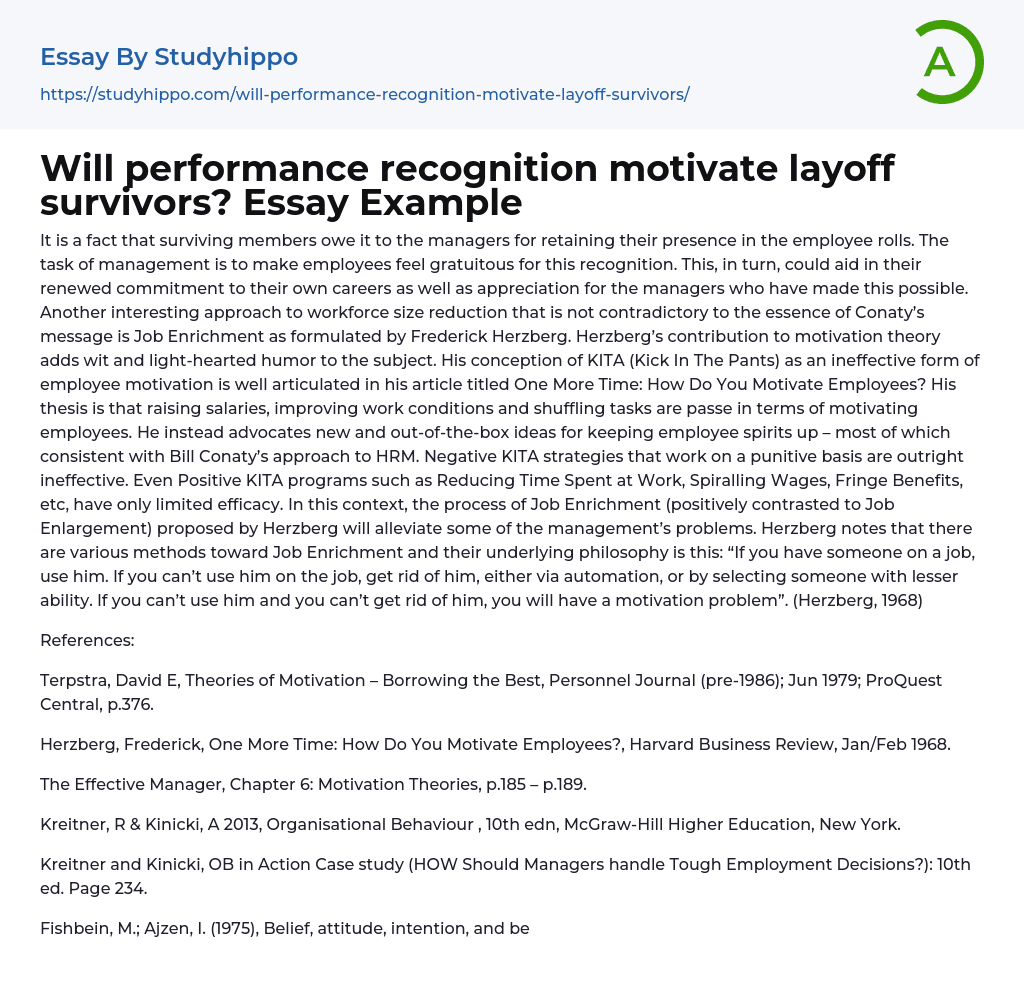

Will performance recognition motivate layoff survivors? Essay Example
The survival of remaining employees is attributed to managers who have retained them on the payroll. It is management's responsibility to foster employee gratitude for this recognition, as it can result in a renewed dedication to their careers and appreciation for their managers. Another method that aligns with Conaty's message for reducing workforce size is Job Enrichment by Frederick Herzberg, which contributes humor and wit to motivation theory. In his article "One More Time: How Do You Motivate Employees?", Herzberg argues against ineffective forms of employee motivation such as salary increases or task reassignments, proposing instead new and unconventional ideas to maintain high employee morale, consistent with Bill Conaty's HRM approach. Strategies relying on punishment, known as negative KITA, are ineffective; even positive KITA programs like reduced work hours or increased wages have limited effectiveness. Within this context, H
...erzberg suggests Job Enrichment as an alternative to Job Enlargement that can alleviate some management issues. According to Herzberg (1968), Job Enrichment offers various methods guided by the philosophy that if someone is assigned a role, they should be effectively utilized; otherwise, if automation or selection of someone less capable occurs, it may be necessary to remove the individual from the job. If none of these options are available, a motivation problem may arise.
References:
Terpstra, David E, explains in his article "Theories of Motivation – Borrowing the Best" in the Personnel Journal (pre-1986) that various theories of motivation can be utilized to enhance employee performance. The author suggests that by borrowing the best aspects from different theories, organizations can create a comprehensive motivation strategy. This article can be found on page 376 of the ProQuest Central database.
Herzberg, Frederick
One More Time: How Do You Motivate Employees?, Harvard Business Review, Jan/Feb 1968.
Kreitner, R & Kinicki, A 2013, Organisational Behaviour, 10th edn, McGraw-Hill Higher Education, New York.
Kreitner and Kinicki, in their OB in Action Case study titled "HOW Should Managers handle Tough Employment Decisions?" on page 234 of the 10th edition, discuss the strategies managers can employ in dealing with difficult employment decisions.
Fishbein, M. and Ajzen, I. (1975). Belief, attitude, intention, and behavior: An introduction to theory and research. Reading, MA: Addison-Wesley.
Murphy, Jim (2009), Inner Excellence, McGraw-Hill, ISBN 978-0-07-163504-2
It is a fact that surviving members owe their presence in the employee rolls to the managers, and it is the task of management to make employees feel grateful for this recognition. This recognition can help renew their commitment to their own careers and appreciation for the managers. Another approach to reducing workforce size that aligns with Conaty’s message is Job Enrichment, as formulated by Frederick Herzberg. Herzberg’s contribution to motivation theory brings wit and humor to the subject. He argues that traditional forms of employee motivation, such as raising salaries, improving work conditions, and changing tasks, are outdated. Instead, he advocates for new and innovative ideas for keeping employee morale high.
- Perseverance essays
- Expressive essays
- Character Traits essays
- Apology essays
- Compassion essays
- Adult essays
- Aggression essays
- Altruism essays
- Archetype essays
- Behavior essays
- Certainty essays
- Conformity essays
- Deception essays
- Human Behavior essays
- Human Sexuality essays
- Maturity essays
- Morality essays
- Obedience essays
- Procrastination essays
- Reinforcement essays
- Role Model essays
- Bias essays
- Big Five Personality Traits essays
- Body Image essays
- Mind essays
- Motivation essays
- Phobias essays
- Thought essays
- Code of Ethics essays
- Conflict essays
- Dress Code essays
- Human Resources essays
- Organizational Behavior essays
- Performance essays
- Recruitment essays
- Safety essays



